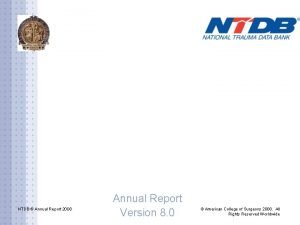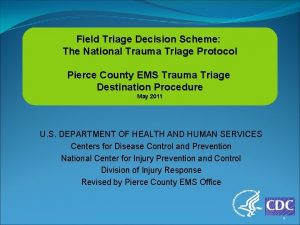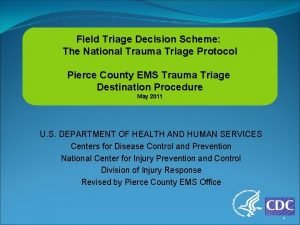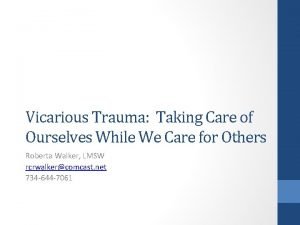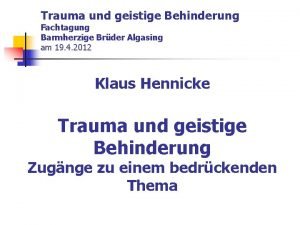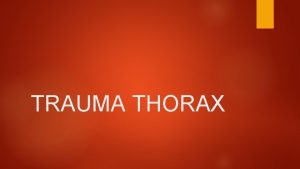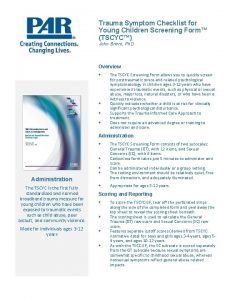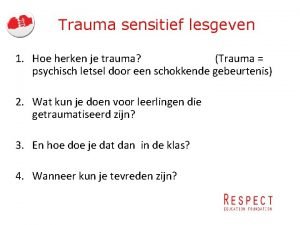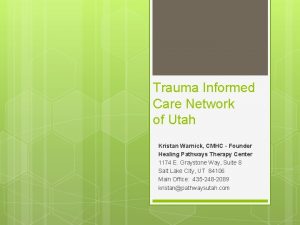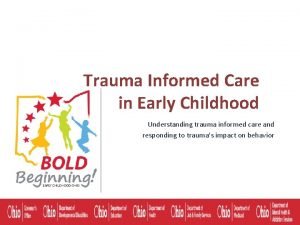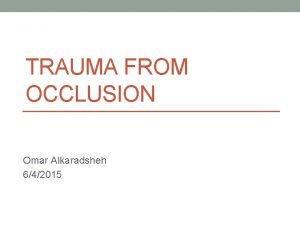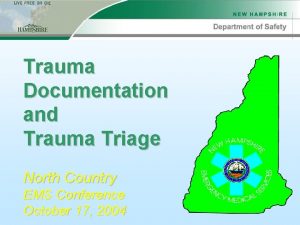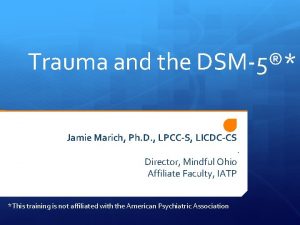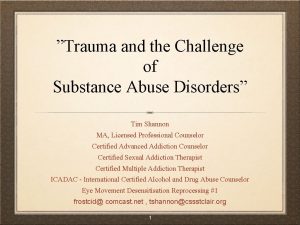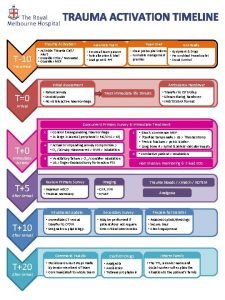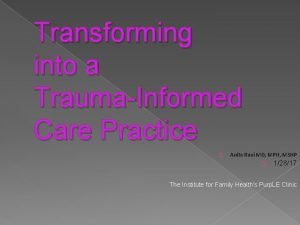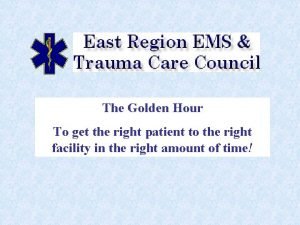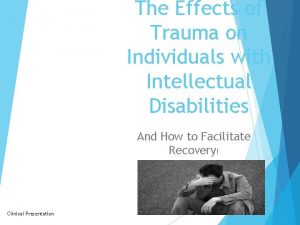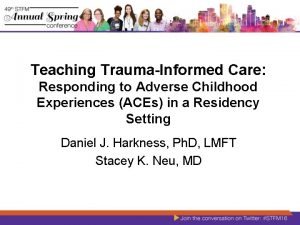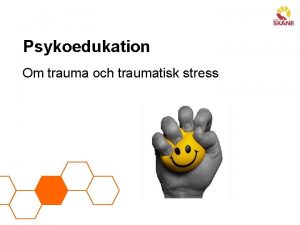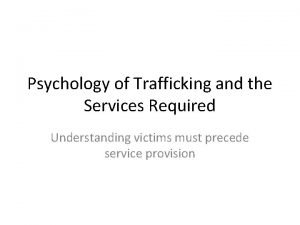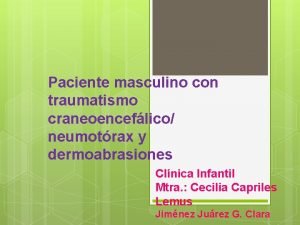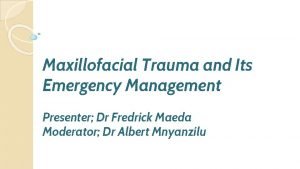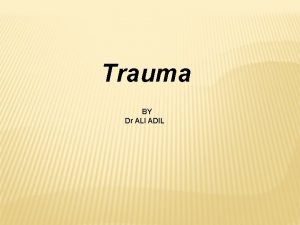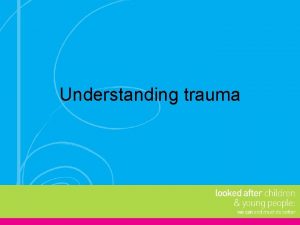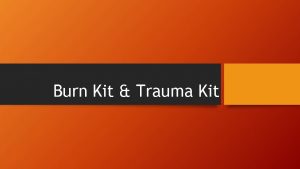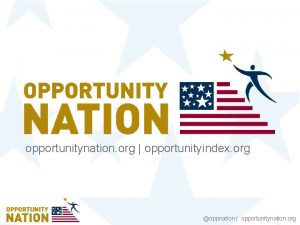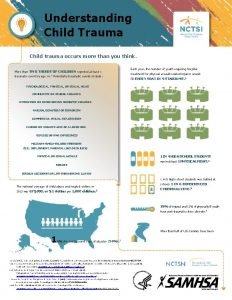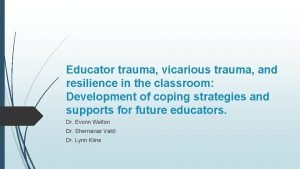National Trauma Campaign Trauma Campaign org infoTrauma Campaign






























- Slides: 30

National Trauma Campaign Trauma. Campaign. org | info@Trauma. Campaign. org #Transform. Trauma #Transform. Childhood. Trauma #HOPEis. NEAR

American Rescue Plan Act (ARPA) ► Backdrop ▪ The COVID-19 pandemic is continuing to impact physical, mental, social, and economic health, and every public system o It also continues to lay bare structural and racial inequities that pre-date the pandemic ▪ ARPA offers: o direct relief (e. g. Child Tax Credit, Stimulus Payments, child care assistance for essential workers) o programs that address issues (e. g. housing, hunger, child care, unemployment) o historic financing wins (e. g. cutting child poverty in half, largest investment in child care) ▪ ARPA funds flow in different ways and have varying deadlines for expenditure: o federal to state o federal state to local o federal to local

American Rescue Plan Act (ARPA) ► Overarching considerations ▪ It can be challenging to public agencies to spend down this amount of money within the limited time allotted ▪ Public agencies are typically understaffed and may be reticent to hire staff with one-time, short-term money ▪ Public leaders are in different places in their understanding of what is encompassed in the term “mental health, ” yet that’s the only term used in ARPA ▪ Public programs are chronically underfunded, so many public leaders will have a wishlist already o Still, many may be looking for ways to use the funds, especially for long-term gain.

American Rescue Plan Act (ARPA) ► Advocacy opportunities ▪ ARPA provisions provide many opportunities to work with state and local policymakers and key stakeholders to utilize the federal dollars to address trauma. o Building up trauma-sensitive/healing-centered systems, environments and approaches is a way that one-time funding can have sustainable, long-term impact ▪ Two “asks”: o Spend funding in support of trauma-sensitive/healing-centered approaches, programs, environments and systems o Make decisions and design/deliver interventions through a traumasensitive/healing-centered lens ▪ The time to start is now and there is still time.

American Rescue Plan Act (ARPA) ► Advocacy opportunities ▪ “Buckets” allowing for TI approaches, programs, and environments: o o K-12 Education and Early Childhood Physical, Behavioral, and Mental Health Care Child maltreatment prevention and Emergency Assistance Aid to State, Local, and Tribal Governments

American Rescue Plan Act (ARPA) ► Advocacy opportunities, cont. ▪ State, Local, and Tribal Governments: o The biggest opportunity is a systems-wide (state, local, tribal) commitment to, and approach for becoming, equipped across all relevant systems, to be trauma-informed/healing-centered o There is flexible financing available to commit to a comprehensive crosssystems effort o Do you have a state champion? o Pennsylvania and New Jersey are exemplars April CTIPP CAN Meeting recording - PA and NJ Statewide Plans New Jersey ACEs Statewide Action Plan Trauma-Informed PA Plan

American Rescue Plan Act (ARPA) ► Advocacy opportunities, cont. ▪ K-12: o Decisions makers are the state education agency and local education agencies. o Ongoing professional development and train the trainer models help school cultures become trauma-informed. This is an opportunity for one-time funding to make lasting change. o Example: New York State issued reopening guidance requiring all school districts to establish a comprehensive, equitable counseling plan, to establish an advisory council of students, parents, teachers, and school mental health professionals, and to hold professional development to all school staff on how to help students develop coping and resiliency skills.

American Rescue Plan Act (ARPA) ► Advocacy opportunities, cont. ▪ Early Childhood Care Settings o Child Care and Development Block Grant ● Offers some flexible funding for state offices of child care o Child Care Stabilization Funds ● State establishes a sub-grant program to qualified child care providers, which allows for spending on “addressing the mental health needs of the staff and children” of one of six (6) allowable items. ▪ Community-Based Child Abuse Prevention Program (CBCAP) o CBCAP offers flexible funds to grantees for the primary prevention of child maltreatment o Unprecedented increase to this program that has been chronically underfunded o Many CBCAP sites use trauma-informed/healing-centered approaches, so there are exemplars

American Rescue Plan Act (ARPA) ► Advocacy opportunities, cont. ▪ Behavioral Health Care o The money allocated to behavioral health and mental health care through existing block grant programs, so this money could be useful toward these systems becoming trauma-informed and healing-centered, if they are not already. o Behavioral Health Workforce Education and Training ▪ Health Care Workers o The secondary and vicarious trauma, as well as direct trauma, experienced by health care workers needs to be addressed, and creating trauma-informed work environments is a key to this. ▪ Mobile Crisis Teams o Encourage states to use this opportunity to develop mobile crisis intervention service teams.




Questions? Thoughts?

Thank you! We don't heal in isolation, but in community. — S. Kelley Harrell jesse@traumacampaign. org | marlo@traumacampaign. org Trauma. Campaign. org | #Transform. Trauma #Transform. Childhood. Trauma #HOPEis. NEAR | info@Trauma. Campaign. org

Resources ● ● Reframing Childhood Adversity: Promoting Upstream Approaches CTIPP’s Summary of the American Rescue Plan Act How Great Leaders Inspire Action See following slides for more! Trauma. Campaign. org | #Transform. Trauma #Transform. Childhood. Trauma #HOPEis. NEAR | info@Trauma. Campaign. org

Campaign Tools – Trauma and Resilience Campaign Infographics

Campaign Tools – COVID Relief ► COVID-19 Video and infographic available for you to use

Possible ARPA Advocacy Activities: Education and Childhood ► Present a plan to your state and local education decision makers to implement ongoing training for every adult in school settings on how to recognize signs of trauma in children—and each other—and to provide meaningful TI supports to promote healing, coping, and resiliency among students and staff. ► Encourage key decision makers to support students who have experienced homelessness and/or poverty during the pandemic by allocating funds to provide support and services to ensure homeless students receive an equitable education and that their families are connected to services as needed. ► Assure local providers know that CAPTA grants can be spent flexibly, from TI workforce training to the promotion of community-based efforts to address primary prevention of child abuse and neglect (e. g. , family strengthening programs, public service campaigns encouraging positive parenting, etc. ) ► Make sure your state’s child care leaders and providers know the training, technical assistance, and supports that work to address the “mental health needs of children and employees” and that ARPA funds may be used for such purposes. ► Example: New York State issued reopening guidance requiring all school districts to establish a comprehensive, equitable counseling plan, to establish an advisory council of students, parents, teachers, and school mental health professionals, and to hold professional development to all school staff on how to help students develop coping and resiliency skills.

Possible ARPA Advocacy Activities: Physical, Behavioral, and Mental Health Care ► Reach out to local decision makers to assure they are aware of the disproportionate impact COVID-19 has had on those who have experienced intersecting, compounding adversity/trauma (e. g. , cultural trauma, historical trauma, adverse childhood experiences, race-based traumatic stress, etc. ) and suggest they implement interventions and programs that address disparities. ► Advocate for state leaders to support ongoing public education efforts by engaging trusted community messengers who can help raise awareness of the traumatic impacts of the last year’s events in impacted communities, de-stigmatize the need for supports, and build trust in service systems. ► Convince decision makers to apportion funds to provide training, technical assistance, and support that results in health care professionals and personnel in all settings knowing how to identify and respond to trauma in their daily interactions with patients, family members, and one another. ► Advocate for key staff to be trained in screening for anxiety, depression, and post-traumatic stress and provide referrals to supportive services in a trauma-sensitive manner. ► Encourage your state leaders to opt in to the five years of federal financing for Community-Based Mobile Crisis Intervention Services that require a team of health care professionals who “are trained in trauma-informed care, de-escalation strategies and harm reduction. ”

Possible ARPA Advocacy Activities: Home Visiting and Emergency Assistance ► Work with state leaders to ensure that the unprecedented increase in resources to prevent child maltreatment and stabilize families are delivered through trauma-sensitive approaches, programs, and environments. ► Encourage local agencies that provide supportive services to vulnerable families to train their workforce on trauma-informed, strengths-based, culturally-relevant home visiting practices. ► Present to state decision makers on the importance of conducting a needs assessment in order to strategize how to meet the diverse needs of eligible families in the state through the provision of home visiting programs and the coordination of trauma-informed services. ► Reach out to key leaders to engage various stakeholders and the community in voicing their needs and sharing decision-making about services that would help best meet evolving community needs. ► Example: the Iowa Department of Health implemented weekly listening sessions with home visitors and used this information to provide families with current data on necessary topics (e. g. , how to navigate changes in food assistance/unemployment benefits).

Possible ARPA Advocacy Activities: Tax Credits ► Join with others in your community to raise awareness around how families (including foster families and kinship/relative caregivers) can pursue these opportunities. ► Help forge collaborative partnerships between free/low-cost tax preparation providers and child welfare/family support service providers such that all who are eligible are supported in obtaining these tax credits. ► Work with state leaders to ensure that the unprecedented increase in resources to prevent child maltreatment and stabilize families are delivered through trauma-sensitive approaches, programs, and environments.

ARPA: K-12 Education ► Section 2001 – Elementary and Secondary School Emergency Relief Fund $122, 774, 800, 000 total – funds remain available until September 30, 2023 ▪ This funding can be used for any of the following purposes: : o Any activity authorized by the ESEA o Activities to address the needs of low-income children and racial/ethnic minorities o Providing mental health services and supports, including through the implementation of evidence-based full-service community schools o Implementing evidence-based activities to meet the comprehensive needs of students o For the 10% retained by the states, not less than 1% each is to be used to fund afterschool and summer programs that among other things respond to the students’ “academic, social and emotional needs” ▪ $800, 000 to address the needs of children who began to experience homelessness during the pandemic ► Decisions about use of funds will be made by Local Education Agencies, Superintendents, and School Boards.

ARPA: Child Care ► Section 2202 – Child Care Stabilization Fund $23, 900, 000 – funds available for states to grant to providers through September 30, 2022 ▪ State agencies may distribute sub-grants to qualifies child care providers to support the stability of the child care sector, including mental health supports for children and employees. ► Decisions about use of funds will be made by qualified child care providers. ► Section 9801 – Child Care Assistance $3, 500, 000 ▪ Grants for states, tribes, and territories for child care assistance pursuant to Section 418(a)(3) of the Social Security Act (Child Care Block Grant Program).

ARPA: Child Abuse Prevention and Treatment ► Section 2205 – Child Abuse Prevention and Treatment $350, 000 total – funds remain available until September 30, 2023 ▪ Provides $250 million for Community-Based Child Abuse Prevention grants ▪ Provides $100 million for CAPTA Title I state grants

ARPA: Mental Health and Substance Abuse Block Grants ► Section 2701 – Community Mental Health Block Grants $1, 500, 000 – the funds shall be expended by September 30, 2025 ▪ Block grants may be used to implement trauma-informed prevention, resilience, and treatment programs given the high correlation between trauma exposure and adverse mental health outcomes. ► Section 2702 – Substance Abuse Block Grants $1, 500, 000 – the funds shall be expended by September 30, 2025 ▪ Block grants may be used to implement trauma-informed prevention, resilience, and treatment programs given the high correlation between trauma exposure and substance use. ► These block grants will are awarded by the Substance Abuse and Mental Health Services Administration (SAMHSA).

ARPA: Support for Health Care Professionals ► Section 2703 – Training for Health Care Professionals $80, 000 ▪ Grants for governments, educational institutions and non-profit organizations to provide training to health professionals to reduce and address suicide, burnout, mental health conditions, and substance abuse disorders among health care professionals. ► Sections 2704 – Education and Awareness Campaign Encouraging Healthy Work Conditions and Use of Mental Health and SUD Services by Health Care Professionals $20, 000 ▪ Local governments, non-profits, and primary/behavioral health care organizations may use this funding to address behavioral health needs that worsened during the pandemic. ► Section 2705 – Grants to Promote Mental Health Among The Professional Health Care Workforce $40, 000 ▪ Grants may be used to establish, enhance, or expand programs to health care entities to promote mental health among their providers, other personnel, and members. ► All three of these funds remain available until they are expended, though it is not clear how these funds will be distributed.

ARPA: Local Behavioral Health Needs ► Sections 2706/2707 – Community-Based Funding for Local Behavioral Health Needs $50, 000 – funds available until expended ○ Local governments, non-profits, and primary/behavioral health care organizations may use this funding to address behavioral health needs that worsened during the pandemic.

ARPA: SAMHSA Trauma-Informed Initiatives ► Section 2708 – National Child Traumatic Stress Network (NCTSN) $10, 000 ▪ Provides additional funding that community entities may use to implement TI programs. ► Section 2709 – SAMHSA Project AWARE $30, 000 ▪ May be allocated to programs that promote resiliency and wellness in education. ► Section 2710 – Youth Suicide Prevention $20, 000 ► Funding goes directly to these SAMHSA programs and remains available until expended.

ARPA: Home Visiting and Emergency Assistance Highlights ► Section 9101 – Emergency Assistance to Families through Home Visiting Programs $150, 000 total – funds available until September 30, 2022 ▪ May be allocated to support home visiting programs, including virtual home visits (as well as providing families with the technological means to conduct virtual home visits). ► Section 9201 – Pandemic Emergency Assistance to Children and Families $1, 000, 000 total – funds available until September 30, 2022 ▪ States and tribes may expend in the form of non-recurrent, short-term benefits (such as cash payments). ► Section 9813 – State Option under Medicaid to Provide Community-Based Mobile Crisis Intervention Services $15, 000 total – funds available until September 30, 2022 ▪ Permits a state to bill Medicaid for 85% of the cost of services provided by a multidisciplinary mobile crisis team for, among other things, persons experiencing a mental health or substance use crisis, where the team includes health care professionals who “are training in trauma-informed care, de-escalation strategies and harm reduction”.

ARPA: Aid to State, Local, and Tribal Governments ► Section 9901 ▪ Provides $130 billion to metropolitan cities, non-entitlement units of local government, and counties to mitigate the fiscal effects stemming from COVID-19. o The funds remain available until December 31, 2024. ▪ Creates a capital project fund that provides $100, 000 to each state and $100, 000 to be divided among tribes and the State of Hawaii for capital projects “directly enabling work, education, and health monitoring, including remote options, in response to the public health emergency with respect to COVID-19…. ” ▪ Creates a Local Assistance and Tribal Consistency Fund of $2 billion, of which $250, 000 is paid to tribes each year in Fiscal Years 2022 and 2023 for any governmental purpose except lobbying. o The funds remain available through September 30, 2023.
 National trauma data bank annual report 2020
National trauma data bank annual report 2020 Field triage decision scheme
Field triage decision scheme National trauma triage protocol
National trauma triage protocol National conference on agriculture for summer campaign
National conference on agriculture for summer campaign National conference for rabi campaign 2020
National conference for rabi campaign 2020 National unification and the national state
National unification and the national state Vicarious felidae
Vicarious felidae Trauma gestig behindert
Trauma gestig behindert Flail chest adalah
Flail chest adalah Trauma symptom checklist for young children
Trauma symptom checklist for young children Trauma sensitief lesgeven
Trauma sensitief lesgeven Trauma awareness and treatment center utah
Trauma awareness and treatment center utah 4 r's trauma informed care
4 r's trauma informed care Trauma informed care lgbtq
Trauma informed care lgbtq Glickman's concept
Glickman's concept Miemss trauma decision tree
Miemss trauma decision tree Examples of little t trauma
Examples of little t trauma Trauma bond
Trauma bond Activation timeline
Activation timeline 4 r's trauma informed care
4 r's trauma informed care The golden hour ems
The golden hour ems Triune brain theory and trauma
Triune brain theory and trauma Trauma-informed care cheat sheet
Trauma-informed care cheat sheet Ucla
Ucla Psykoedukation ptsd
Psykoedukation ptsd Trauma bonding meaning
Trauma bonding meaning Dermoabraciones
Dermoabraciones Emergency management of maxillofacial trauma
Emergency management of maxillofacial trauma Descerebración y decorticación
Descerebración y decorticación Ocular trauma score
Ocular trauma score Adhd vs trauma
Adhd vs trauma
